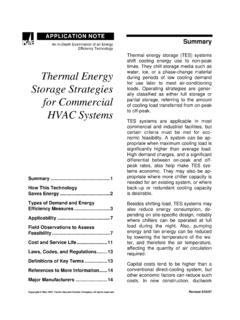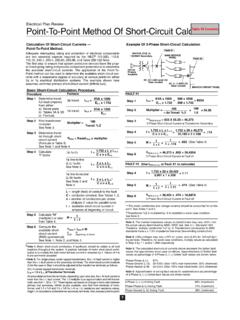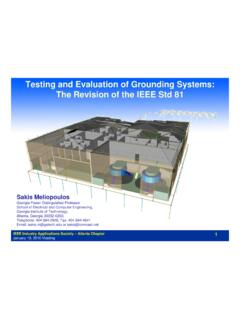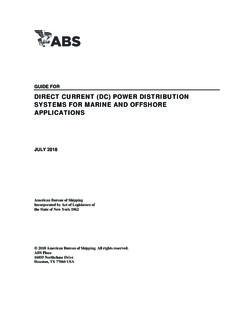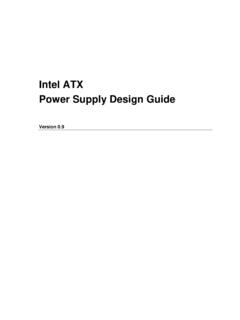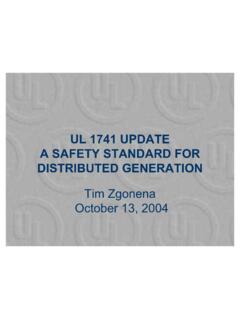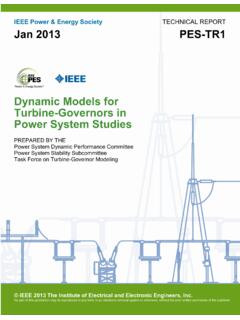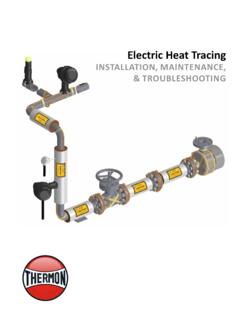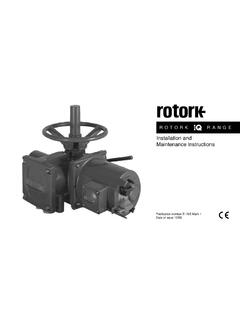Transcription of Voltage Tolerance Boundary - Pacific Gas and Electric …
1 Pacific Gas and Electric Company Voltage Tolerance Boundary The only national standard for utilization Voltage regulation is ANSI Its title is American National Standard for Electric power Systems and Equipment Voltage Ratings (60 Hertz). The first version in 1954 was a combination of two standards, one from the Edison Electric Institute that represents utilities and the second from NEMA that stands for National Electrical Manufacturers Association. It establishes nominal Voltage ratings for utilities to regulate the service delivery and it establishes operating tolerances at the point of use. The design and operation of power systems and the design of equipment to be supplied from such systems should be coordinated with respect to these voltages. In doing so, the equipment will perform satisfactorily in conformance with product standards throughout the range of actual utilization voltages that will be encountered on the system.
2 These limits shall apply to sustained Voltage levels and not to momentary Voltage excursions that may occur from such causes as switching operations, fault clearing, motor starting currents, and the like. To further this objective, this standard establishes, for each nominal system Voltage , two ranges for service Voltage and utilization Voltage variations, designated as Range A and Range B, the limits of which are illustrated in figure 1 based on a 120 volt nominal system. Figure 1. Voltage Ranges, ANSI 128126124120116114112110108106104 Voltage (120-V Base)(b)(a)Service VoltageSystems of more than 600 V127(a)Utilization VoltageService Voltage120-600 V SystemsService VoltageSystems of more than 600 VUtilization VoltageService Voltage120-600 V SystemsNominal SystemVoltageRange ARange B NOTES: (a) These shaded portions of the ranges do not apply to circuits supplying lighting loads (b) This shaded portion of the range does not apply to 120-600-volt systems.
3 (c) The difference between minimum service and minimum utilization voltages is intended to allow for Voltage drop in the customer s wiring system. This difference is greater for service at more than 600 volts to allow for additional Voltage drop in transformations between service Voltage and utilization equipment. 1 Basically, the Range A service Voltage range is plus or minus 5% of nominal. The Range B utilization Voltage range is plus 6% to minus 13% of nominal. For range A, the occurrence of service voltages outside of these limits should be infrequent. Utilization equipment shall be designed and rated to give fully satisfactory performance throughout this range (A). Range B includes voltages above and below Range A limits that necessarily result from practical design and operating conditions on supply or user systems, or both. Although such conditions are a part of practical operations, they shall be limited in extent, frequency, and duration.
4 When they occur, on a sustained basis, corrective measures shall be undertaken within a reasonable time to improve voltages to meet Range A requirements. Insofar as practicable, utilization equipment shall be designed to give acceptable performance in the extremes of the range of utilization voltages, although not necessarily as good performance as in Range A. It should be recognized that because of conditions beyond the control of the supplier or user, or both, there will be infrequent and limited periods when sustained voltages outside Range B limits will occur. Utilization equipment may not operate satisfactorily under these conditions, and protective devices may operate to protect the equipment. ANSI C84 does not explain that typically, the nameplate nominal Voltage is not the same as the utility nominal Voltage . Refer to table 1. ANSI C84 also does not explain that in general, NEMA, National Electrical Manufacturers Association recommends that all electrical appliances and motors should operate at nameplate plus or minus 10% satisfactorily, however not necessarily at an optimum condition.
5 The reason that the nameplate nominal is lower than the service entrance Voltage is the acknowledgment that there will be a Voltage drop within the electrical distribution system of the end users premise. The National Electrical Code allows up to a 5% drop. There can be a <3% drop in a feeder and an additional <3% drop in individual branch circuits. Table 1. National Steady State Voltage Regulation Standards Nominal Service Utilization Nameplate NEMA Standard -5%, +%5 -13%, +6% Motor -10%, +10% 120 114 - 126 - 115 - 208 - 181 - 200 180 - 220 240 228 - 252 - 230 207 - 253 277 - 241 - 480 456 - 504 - 460 414 - 506 bandwidth bandwidth bandwidth 10% 19% 20% Utilities actively regulate distribution voltages slowly by means of tap changing regulators and by switching capacitors to follow changes in load.
6 These Voltage changes are small incremental steps necessary to keep the service delivery Voltage within an acceptable range as customers add and subtract load during the day. This slow regulation maintains a sustained Voltage range. Sustained usually means a period greater than two minutes. 2 The reason for the CBEMA curve is for changes in Voltage shorter than two minutes. As described above, there will be excursions outside the acceptable ranges for short momentary periods. Duration of Disturbance in Cycles (c) and Seconds (s)Footnote: ITIC = Information Technology Industrial CouncilCBEMA = Computer and Business Electronic Manufacturers AssociationANSI Steady State values are plus 6% to minus 13% measured atend-use equipmentNEW ITIC VALUES 1996 OLD CBEM A CURVE 1977 Computer and electronic equipment manufacturers usually specify maximum momentary Voltage deviations within which their equipment can operate without sustaining errors or equipment damage.
7 This curve shows an envelope of Voltage tolerances that is representative of power -conscious computer and other electronic equipment manufacturers. The original CBEMA curve is referenced in ANSI/ ieee Std 446-1987, A recommended Practice for Emergency and Standby power Systems for Industrial and Commercial Applications. The CBEMA group has changed names to ITIC to represent a broader spectrum of the industry. The wider Tolerance curve was created in 1996 to indicate the improved ride through capability of power conscious manufacturers. The original CBEMA curve was established as a guideline 3 for computers in data centers with extensive power quality mitigation measures in place such as motor-generator sets and isolation transformers. For equipment located outside this protected environment, there will be frequent events outside the curve. Some power quality monitors now include the CBEMA/ITIC mask to provide a frame of reference when reviewing recorded events.
8 The assumption is that events within the curve should not cause disruption or damage. Equipment experiencing problems will need some form of mitigation to isolate itself from the electrical distribution system. Before mitigating these disturbances, it is important to understand the equipment s sensitivity level. There are no general equipment susceptibility standards for momentary Voltage variations. For a general description of power quality issues and solutions there are three good publications. These are described at the end of this power note. The microelectronics industry has produced two standards in view of the extremely high losses due to power variations in the manufacture of microelectronics; SEMI E10 Standard for Definition and Measurement of Equipment Reliability, Availability, and Maintainability; and SEMI F42 Test Method for Semiconductor Processing Equipment Voltage Sag Immunity.
9 E10 defines the sag ride through capability. F42 defines the test methodology to confirm compliance to the standard. These standards are available from Semiconductor Equipment and Materials International (SEMI), 805 East Middlefield Road, Mountain View, CA 94043. Their web address is Basically, that industry has decided that if they properly define the problem and provide for a performance test procedure when purchasing new production equipment, they can reduce the number of nuisance tripping problems. An analysis of 30 monitor years of disturbance data collected at major semiconductor manufacturing sites revealed that of the events were below the CBEMA 1996 Tolerance curve. The average number of occurrences below the CBEMA 1996 curve per site per year was The SEMI task force concluded that a higher standard was needed. Duration of Voltage Sag in Seconds% of Equipment Nominal Figure 2.
10 SEMI E10 Voltage Sag Ride-Through Curve 4 Figure two is the approved SEMI E10 Voltage Sag Ride-Through standard. This was determined by statistical data analysis of the frequency and duration of sags and the cost to incorporate ride through mitigation. If you are interested in the development of the SEMI standard, there is a web site where it is spelled out in a document available to the public. The document s name is Guide for the Design of Semiconductor Equipment to Meet Voltage Sag Immunity Standards. The web site address is It is classified as a Technology Transfer document #99063760A-TR. Figure three is an overlay of the CBEMA curves and the SEMI E10 curve. The principal improvement in the SEMI curve is lowering the sag ride through curve down to 50% of nominal for the first 200 milliseconds or about 12 cycles. Beyond 12 cycles, the SEMI curve mimics the new CBEMA curve.









